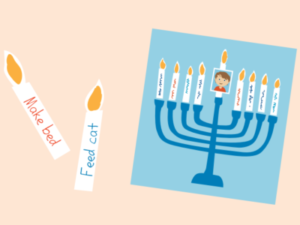During Hanukkah, we use the shamash, or helper candle, to light all the other candles on the hanukiyot, menorah.
What does it mean for a person to be a shamash? It means that we have the ability to do good in this world through our actions. By sharing our light, we kindle the light of hope in others, even during dark times.
Read Shine the Light for our Littlest Ones, a blog by Federation’s Director of Jewish Educational Initiatives Emily Fox.
Be a Shamash Activity
This craft activity from PJ Library is a fun reminder that when you help other people, you light up the world.
Supplies
- Construction paper
- Pencil
- Scissors
- Tape or glue
- Markers
- A photo of you
Draw an empty menorah on a piece of construction paper. Draw nine candles on another piece of construction paper and cut them out. Choose one candle to be the shamash and attach a photo of yourself to it with tape or glue. Attach the shamash candle to its place on the menorah.
 Now think of eight things you can do to help people around you and write one act on each of the other eight candles. During Hanukkah, do one of these helping acts each day. As you complete each act, add the corresponding candle to your menorah. When the menorah is full, it’s time to celebrate — what an amazing shamash you are!
Now think of eight things you can do to help people around you and write one act on each of the other eight candles. During Hanukkah, do one of these helping acts each day. As you complete each act, add the corresponding candle to your menorah. When the menorah is full, it’s time to celebrate — what an amazing shamash you are!
Check out the PJ Library Hanukkah Hub for book lists, recipes, activities, videos and songs, and much more!
Share the Light
Please share your Hanukkah photos and activities on our Facebook and Instagram pages! We’d love to see you using your shamash to light the candles being a shamash by helping others, throughout the week of Hanukkah! Use hashtags #IamGMW, #ShineALight, and #ShineALightGMW.
The “Be a Shamash” project is brought to you by Federation’s Jewish Community Relations Council as part of our partnership with Shine a Light, a national program designed to raise awareness of the effects of antisemitism in our country.
Talking to Children About Antisemitism
Many sources recommend being direct with kids about difficult topics while also tuning in to gauge how much your kids can handle.
The American Psychological Association stresses that for children in groups that are likely to be targets of discrimination, it’s vital for parents to have ongoing, honest, discussions with their children rather than shying away from the subject. The APA also recommends:
- Let the discussion be ongoing.
- Keep talking. Yes, even – and especially – when it gets hard. Remember, it’s also ok to say, “I don’t know.”
- Be age appropriate. Keep things basic. Young children especially need simple information balanced with reassurance.
- Encourage your children to ask questions.
- Help kids learn how to deal with being the potential target of discrimination.
- Develop healthy comebacks or responses to hurtful discriminatory statements. For example: “What an unkind thing to say.” “Excuse me? Could you repeat that?” “I disagree with you, and here’s why…”
- If you catch your child using insensitive language, use the moment as a teaching example.
- Model good behavior for your child.
For more ideas, read “Taking a Stand Against Antisemitism” by Rachel Fish, Ph.D. Executive Director, Foundation to Combat Antisemitism, proud PJ Library parent, and member of the PJ Library NextGen Board.
Guide to Countering Antisemitism
Written in partnership with USC Shoah Foundation, Nickelodeon’s Talk and Take Action: Parents’ & Caregivers’ Guide to Countering Antisemitism provides a comprehensive roadmap will help you determine what your child is ready to learn, prepare you for these difficult conversations, and offers strategies, resources, and much more.
“We recognize having conversations focused on discrimination and hate can be challenging at any age. We hope this guide will help parents and caregivers feel supported as they navigate these tough topics with their kids. Finally, we want our families to leave these conversations empowered to make change. This guide provides simple, but significant, action steps families can take together to create a more inclusive world.”

